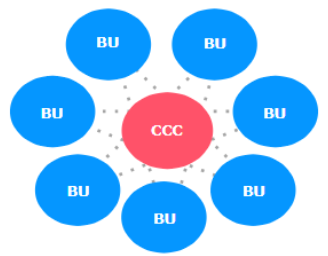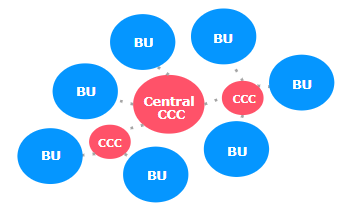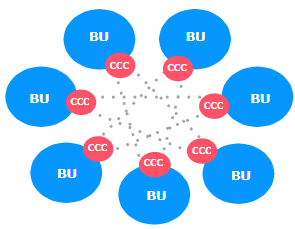Sustaining RPA
Automation sustaining pillars
Pillar 1. Benefits management
Benefits identification, quantification and ongoing management is imperative for RPA programmes to demonstrate value and create momentum within the organisation.
The primary aim of RPA is to release capacity for clinicians and other front, support and back-office staff so they can be more efficient in dispensing valuable, skilled activities.
To that effect, benefits management starts at the onset of delivery with the creation of an outline business case. In addition to process metrics, this should account for digital maturity – for example, legacy systems, levels of interoperability, system or application standardisation, and data source.
By building this initial, quantified view, the benefits can be validated and monitored throughout the delivery lifecycle to ensure that opportunities are progressed, paused or stopped altogether based on robust evidence.
Business case and return on investment (ROI) model
The intent of the outline business case is to help process owners understand the level of benefit they are likely to achieve through automation. This allows opportunities with the greatest return to be prioritised and implemented at pace.
Here we have used demand generation and triage processes to help the RPA teams to progress the right opportunities through cost/benefit analysis and establishing the right baseline to measure against.
These are the core components for developing the outline business case and ROI model. The business case and ROI will evolve as the solution is developed and delivered. It typically follows the steps as shown in the diagram below.
It should be used as a constant touch-point between the RPA teams, stakeholders and process owners to ensure that the solution delivered meets expectations and that the defined benefits will be realised. Throughout the programme, RPA teams should put in place the necessary touch points so that the benefits can be managed through the governance framework:
- Validate the opportunity - validate target state and potential use cases to determine processes under preview can be automated
- Analyse and develop automation options - develop options for automating processes using the available technology
- Evaluate Options - perform cost to benefit analysis of developed options to determine return on investment
- Implementation Strategy - define implementation strategy based on complexity of implementation
- Recommendations - recommend processes to be automated
Join the NHS National Community of Practice for RPA to access our ROI and benefit case examples
Pillar 2. Automation target operating model (ATOM)
Defining and implementing an operating model that includes people, processes and technology infrastructure that supports RPA sustainability will help achieve and establish maximum value. These are some key factors:
RPA can play an important role in driving end-to-end operational outcomes, such as creating more capacity for staff to focus on providing the best care they can. As initial RPA deployments prove to be effective, teams should explore strategies for expanding across the organisation.
Multiple options are available to scale; here we consider one, the creation of a Central Competence Centre (CCC)* or RPA Hub. Establishing an RPA Central Competence Centre drives value, benefit and improved outcomes for RPA delivery.
CCCs bring together the management, best practices, research and training related to delivering and sustaining RPA across the organisation.
Note: * If you are starting your automation journey, then you don’t need to become a CCC or RPA Hub. To find out more about RPA Hub in your region reach out to us.
When identifying the appropriate ATOM, there are key factors to consider:
Scaling beyond proof of concepts (PoCs)
- Automated solutions are generally used for a wide variety of processes across different parts of the organisation and often initially delivered at small scale through PoCs.
- A key question, therefore, is how to scale and deliver enterprise-wide value, including combining with existing systems – for example, through using application programming interfaces (APIs) and in the future to incorporate new technologies, such as artificial intelligence (AI), whilst aligning with compliance and risk management requirements.
- The setting up of a CCC is a good way of coordinating and monitoring these efforts.
Start with the simple questions
While a CCC can provide guidance on building, sustaining, scaling and embedding automation across the organisation, there are “simple” questions that often create roadblocks and need to be addressed upfront:
- Where and with whom does ownership of RPA sit within the organisation?
- What is involved?
- How many people are needed, and what expertise is required?
- How long will this take?
- What is an estimated budget?
- Is there an option to leverage or integrate partially with an existing competence centre in the wider NHS to benefit from their experience and de-risk initial setup and delivery while reducing delivery turnaround times?
But don’t underestimate the detail
- It is crucial to address these questions; creating a charter is one tool for providing the framework for evaluating proposed processes, and fostering the skills, methods, tools, and technologies to most effectively implement the automation.
- Clear roles and responsibilities must be addressed up front, and clearly defined across all key stakeholders within the organisation. For example, different groups within IT may need to be involved, as they are responsible for different applications and provision of the platform itself; as CCC stakeholders, they will offer remarkably different insights from within and across IT functions.
There are 3 key options that form the basis of designing and standing up any Central Competence centre (CCC) or hub.
Centralised

One CCC serving all business units (BU).
Pros
- One platform to provide centralised support for all lines of business
- Easier to disseminate skills, methodologies, lessons learned and best practices
- Standardised RPA design, development and support process
Cons
- Automation prioritisation challenge: some lines of business might struggle to meet central ‘one size fits all criteria’ to make the cut
- Slower RPA deployments
Hub and spoke/federated

One central CCC, linked to federated CCC dedicated to business units (BU).
Pros
- The Central CCC handles most complex projects while federated CCC cover the rest
- Reduction in prioritisation challenge, with federated CCC dedicated to lines of business and functions
- Higher functional process knowledge can be built within federated CCC, given their proximity to businesses
Cons
- Lack of collaboration can lead to discrepancy in expertise, governance and methodologies between Central & Federated CCC
Decentralised

Independent CCC for each business unit (BU).
Pros
- Each business unit drives their individual automation programmes and their prioritisation
- All RPA CCCs are close to individual business units
Cons
- Regular exchange of best practices across separate CCC must be enforced
- High risk of incoherence in standards, governance, methodologies & support levels
- Certain CCC roles will be duplicated
Pillar 3. Govern
Organisations will require a holistic framework for managing and scaling the ATOM and RPA programme capabilities in an effective manner by embedding appropriate governance and enablement policies.
The Govern Pillar has two sections – 3a. Governance and 3b. Business Change.
Pillar 3a. Governance
An effective governance framework will help outline design principles and decisions across people, process and technology design elements.
RPA projects require multi-functional coordination across several teams. Therefore, the framework provides leadership, coordination, and best practices for the most efficient delivery of the project.
This is even more critical in the context of delivery of health services, as any new digital pathways should account for impact on patient care and safety. As part of overall governance for RPA programmes, they should build in a detailed risk management plan and ongoing engagement with clinical safety officers and clinical governance committee and leads to ensure clinical risk is minimised.
The framework allows for combining multiple technology, process and data solutions to empower and assist staff.
The framework enables benefits realisation and ensures ROI.
-
People and skills
- Roles and responsibilities
- Training and upskilling; team mix – internal vs external vs hybrid
- Providing assurance to staff on value added
- Mitigating risks for neurodiverse and disabled staff
-
Governance and standards
- Assessment and prioritisation standards
- Development governance
- Operations governance
- Regulations, requirements and compliance
-
Process and delivery
- Enforce secure coding
- Scoring and ROI
- Reusability of assets
- Establish development best practices to avoid waste
-
Technology
- Track tool usefulness
- Security standards
- Manage scalability
- Bot infrastructure and licenses
- Platform and bot management and maintenance
Pillar 3b. Business change
Change management and the focus on embedding new ways of working as part of culture needs to be part of delivery to influence a mindset shift.
To define and deliver the interventions required to make the organisational shift that is required to embed automation solutions within the NHS, we recommend using a change framework consisting of the following points to consider:
- Case for change
- Future state
- Readiness for change
- Change leadership
- Stakeholder resistance management
- Communications
- Training and people development
- Organisational alignment
- Culture
Ideally, these activities should be included as part of the delivery roadmap across every phase of the programme. This will ensure impacted NHS and its staff are ready, willing, able to deploy and sustain automation solutions. It will also support key activities to build the foundations for change, deliver change throughout, and make it stick through inflight and early life support actions.
The change framework should provide a robust approach to support the communication strategy and other change management interventions to ensure that stakeholder management is embedded in all phases.
Pillar 4. Enable
This pillar has three sections – 4a. Training and upskilling, 4b. Accelerators and assets, 4c. Innovation and continuous improvement.
Pillar 4a. Training and upskilling
Organisations will need to invest in upskilling staff and teams in key skills and tools to support the delivery and adoption of automation.
The RPA CCC team should provide knowledge and capability building for Automation in wider organisation across lines of business. This capability can be curated, built and developed within the CCC and leveraged across the business. This capability should:
- Create and deploy a role-based NHS Automation Capability Framework
- Provide Automation Capability Maturity Assessment tools and services to determine training needs
- Curate, develop and deploy a range of learning resources
- Taking steps to engage and consult with neurodiverse and disabled staff
- Provide ongoing coaching and capability development
The initial focus should be on CCC staff, however as the programme matures, the learning resources should be made available to all staff to support adoption across the business, with a specific focus on a group of key team leaders who will be coached in operational excellence.
The learning approach, formed by insights from other automation programmes, should leverage a multi pronged strategy:
Plan for design, delivery and continual management of training and skill requirements from initial RPA programme set-up through to business as usual.
The ongoing process for managing training needs starts with confirming the CCC Roles RACI (responsible, accountable, consulted and informed) and using this to create the CCC capability maturity framework. This will describe the automation capabilities required across a range of maturities (developing, performing and excelling) and will be used to complete individual and team assessments, and personalised Training Needs Assessment (TNA). Along with the CCC Role RACI, this can also be used to guide and inform recruitment into the CCC as part of your transition state approach and to create role-based learning paths.
Ongoing management of training
- Confirm CCC roles - the activity/role RACI matrix informs CCC capability needs
- Create capability maturity framework - adapt capability framework for all CCC roles. Use to help development and recruitment.
- CCC team assessments and TNA - individual assessments and training needs analysis will create learning need.
- Facilitate and deliver CCC upskilling - deliver learning interventions according to agreed need.
- Ongoing coaching and mentoring - on the job individual and team coaching of CCC team.
- Regular CCC capability reviews - re-assess individuals as their experience and skills grow.
- Create CCC learning pathways - create pathways for each CCC role and capability level.
- Create CCC learning portals and materials - creating and curating automation content.
Pillar 4b. Accelerators and assets
Using standardised templates and tools can help significantly increase the pace of delivery and hence shorten the timelines to benefits realisation.
Tried and tested techniques, templates and tools can significantly accelerate the pace of RPA delivery programmes. They can be utilised from the outset and incorporated quickly into the RPA delivery capability teams and avoid the need to establish them from the ground up.
The teams should also encourage development of reusable assets at every stage of delivery to continue to add to the set of accelerators that other teams can draw upon as they set up their programmes. Innovation exchanges or automation marketplaces can be effective ways of collating, managing and sharing this collateral across programmes.
Recommended list of templates or frameworks for RPA delivery programmes:
Pillar 4c. Innovation and continuous improvement
To drive continued growth, improvement and value from RPA programmes, it is important to consider approaches to embedding Innovation and a continuous improvement (CI) culture.
Innovation and CI is an essential mechanism to keep the NHS’s automation and business process improvement services as valuable as possible.
These programmes can make an important pillar of cross organisation partnership to solve existing and emerging business and operational challenges and opportunities.
An innovation and CI approach can be built into the automation delivery roadmap from three perspectives:
- Leverage existing capabilities (reviewed on every process design)
- Bring in new capabilities (strategy, typically reviewed once a quarter)
- Explore disruptive concepts (on demand, internally or in partnership)